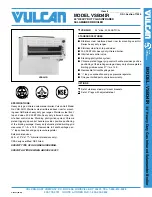
9
EN
• Thermostat adjustable between 60 and 90 °C
(item marked 1,
illustration B).
Central heating systems are generally designed to
operate at a maximum of 80° C. When used at lower temperatures,
a 3-way mixer valve installed on the heating flow pipe
(see illustration G)
allows the temperature to be set manually or, if you decide to install
a regulator
(§ controller kit, page 3)
, automatically.
We recommend that you set the thermostat to the maximum values
to get the best out of the domestic hot water system.
There is a risk of scalding from very hot water.
The water stored in the domestic hot water tank in the boiler can be
at a very high temperature.
In any case you should install the thermostatic mixing valve
(see illustration H)
, on the domestic hot water heating flow pipe, which
should never rise above 60 °C. A mixer or mixing valve at each point
of use is recommended.
• ON/OFF switch
(item marked 2, illustration B).
This must be used to switch the boiler off before carrying out any
work on it.
• Summer/Winter selector switch
(item marked 3, illustration B).
“Winter” position: provides both domestic hot water and central
heating functions. “Summer” position: The room thermostat or
regulator
(§ controller kit, page 3)
is switched off. The central heating
circulator is also switched off. Only the domestic hot water function is
provided. You can use the thermostat (1) to reduce the temperature
and save energy. If there is not enough hot water available, we
recommend setting the thermostat (1) to its maximum value.
When the weather turns cold again, simply select “Winter” to
reactivate the heating system.
• Thermometer
(item marked 4, illustration B).
Reads the boiler primary circuit
(central heating)
temperature directly.
• Regulator
(item marked 5, illustration B).
Please refer to the enclosed instructions if you have chosen this option.
◆
CENTRAL HEATING SYSTEM GAUGE PRESSURE
Your system is fitted with a central heating safety valve, set to 3 bar,
which is fitted with a pressure gauge.
First make sure that the water in the system is still pressurised. When
cold and after the air in the system has been bled, the pressure
gauge should show a pressure of between 1 and 2, depending on
the height of the building: (1 bar = 5 m / 1.5 bar = 10 m / 2 bar = 15 m).
To add water, open the filling valve
(item marked 5, illustration G)
. Make
sure the valve is properly closed after filling. Bleed the air in the
system to get an accurate water pressure reading.
◆
SAFETY VALVE
(central heating) (item marked 2, illustration G)
A monthly inspection is recommended:
Lift the lever on the emptying device for a few seconds to ensure that
the safety valve is working properly.
The discharge pipe to the drain must be iaw
current regulations.
If you notice anything unusual after this short trial,
please inform the installing engineer.
◆
SAFETY UNIT
(domestic hot water) (item marked 1, illustration H)
A monthly inspection is recommended:
Lift the lever on the emptying device for a few seconds to ensure that
the safety valve is working properly.
The discharge pipe to the drain must be iaw
current regulations.
If you notice anything unusual after this short trial,
please inform the installing engineer.
◆
OIL BURNER - RESETTING
(see illustration O)
If the red light on the burner lights up, this indicates an operating fault.
Wait five minutes before resetting the burner by pressing the button
located on the cover.
If the burner fails to start up again, call the installing engineer after
ensuring that the fault is not due to a power cut or low oil in the tank.
◆
OIL BURNER WITH AIR VALVE - RESETTING
(see illustration P)
If the burner is not working:
1.
Remove the protective cover.
2.
If the red alarm light is lit, press this reset button to restart the
burner.
3.
If the burner is working, replace the protective cover.
If the burner is not working, isolate the electricity
supply before removing the font panel.
4.
Remove the front panel and reset the safety thermostat located
on the top of the boiler.
(see illustration Q)
Wait until the boiler temperature drops below 60 °C.
Then replace the front panel.
5.
If the burner is working, replace the burner cover.
6.
If the fault persists, please notify the installing engineer.
Starting the burners.
In normal operation the burner is started up automatically when the
boiler temperature is below the setpoint temperature.
To ensure your system operates properly, have it
professionally serviced once a year before the start of
the heating season.


































